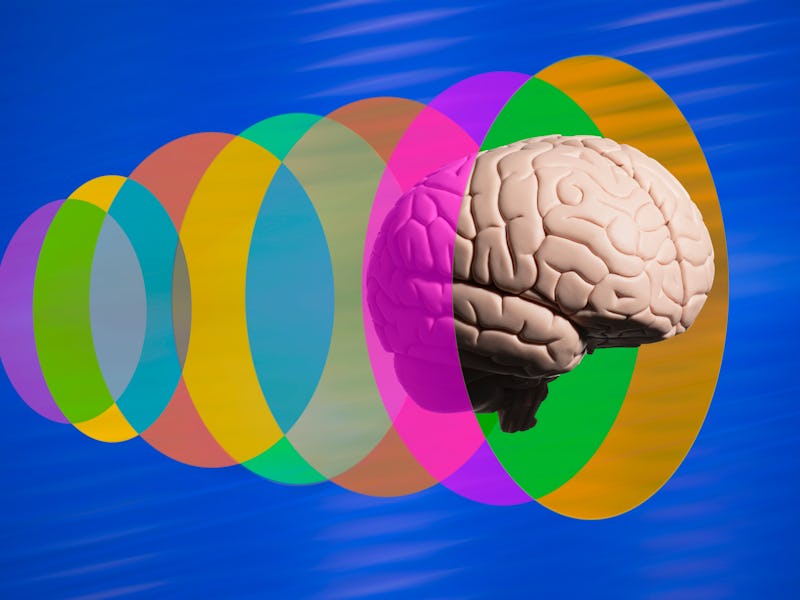Brain "Fingerprinting" Reveals The Moment Consciousness Alters During A Psychedelic Trip
Everyone has their own unique psychedelic trips. Researchers are mapping them out to uncover unique brain “fingerprints.”

Fingerprints have long been the hallmark of individual identity — the loops, whorls, and arches combined into an uncommon, unique pattern. It turns out we have a similar unique signature in our brains. Also known as functional connectomes, brain fingerprinting aims to broaden our understanding of how each person’s neural architecture relates to pain perception or the state of one’s mental health.
For scientists like Enrico Amico, a computational neuroscientist at École Polytechnique Fédérale de Lausanne (EPFL) in Switzerland, brain fingerprinting presents a perfect opportunity to see what our brains look like on psychedelics drugs like psilocybin, which is being explored for conditions like depression and alcohol use disorder.
“Psychedelics have a deep effect on our brains that is unique to every one of us,” Amico tells Inverse. “[But] where are the differences, in which parts of the brain, and do they relate to the subjective experience of the drug?
Now, in a preprint published last week on bioRxiv, Amico has some answers. Looking at functional brain scans of a group of healthy, young individuals high on psilocybin, Amico and his colleagues at EPFL found that among psilocybin users, their brains demonstrated unique responses (i.e., the fingerprints) that corresponded with activation in a group of brain regions collectively called the default mode network, a functional system that appears strongly when we’re in a resting state.
These results are still preliminary, but Amico hopes they offer a better way to research and devise personalized therapies with psychedelics.
Your consciousness on psilocybin
A problem in neuroscience when trying to map out the brain and better understand neurological disorders like Alzheimer’s disease or even healthy individuals is that neuroimaging studies make inferences about certain populations based on group averages. This technique has so far failed to address the spectrum of individual differences for a disease or response to a pharmacological drug.
Brain fingerprinting is a relative newcomer to the neuroscience scene, first used in 2015, but has quickly become a hot topic of research, especially for psychedelics. For example, psilocybin is known to alter self-perception profoundly — what’s called an altered state of consciousness — but the “trip” to get there varies from person to person.
To better understand what drives these unique experiences in the brain, Amico and his team analyzed functional MRI brain scans they obtained from Jan Ramaekers, a professor of psychopsychology at Maastricht University in the Netherlands. These brain scans were of 46 healthy volunteers, mostly in their twenties, half of whom were given around 10 milligrams of psilocybin before entering the functional MRI scanner and the other half a placebo.
Amico and his colleagues saw that the brain fingerprints of participants given the placebo centered around the lateral prefrontal cortex, a brain area involved in executive functions such as decision-making, cognitive control, emotional regulation, and abstract thinking.
For the psilocybin users, the researchers visualized an entirely different brain fingerprint. Each person had their own, but they all centered around, in various degrees of brain activity, the default mode network.
“People think of the default mode network as our workspace, like a network that integrates signals and senses information from the outside to the inside and is associated with many higher cognitive functions like consciousness,” says Amico.
He likens the findings to a QR code where we all have our unique configuration of lines. With psilocybin use, the lines making up the bar code shift around. Translating what that looks like in the brain is a functional reconfiguration of brain connections strongly predictive of the subjective psilocybin experience as the default mode network became engaged.
“The more you were feeling the trip, the more your brain was reconfiguring into that state,” says Amico. “That was very interesting for us to see.”
Laying the groundwork
What’s guiding someone’s unique brain-on-psychedelics fingerprint isn’t clear. There could be a multitude of factors like genetics or even the microbiome. It’s important to bear in mind that these findings are based on healthy individuals who were experiencing a psychedelic trip at the time of their brain scans, says Greg Fonzo, co-director of the Center for Psychedelic Research and Therapy at the University of Texas at Austin Dell Medical School.
“This is in healthy people, so we can’t necessarily generalize this to a clinical population,” Fonzo tells Inverse. “It’s exciting, but it’s preliminary. We shouldn’t just accept this as a ground truth.”
Fonzo does believe these sorts of brain fingerprinting studies with psychedelics could lay the groundwork for understanding the interactions between a psychedelic and one’s unique brain function.
“Ideally, in the future, you might be able to use these techniques before people take psilocybin to differentiate those that may respond better to the experience,” he says. “But that’s still a long way off.”
This avenue of neuroscience translating to clinical application is what Amico is hopeful for. He hopes this study will drum up more interest in pharmacological brain fingerprinting as a means of personalized medicines and other therapies.
“If [your] brain is reacting to a drug in a certain way and my brain is reacting to the drug in another way, then it’s important to figure out which parts of my [and your] brain are reacting so we can infer personalized medicine based on the features that we have,” Amico says. “There’s more to find out, why this is happening and in which way we can use it. It’s a very exciting new field.”
This article was originally published on